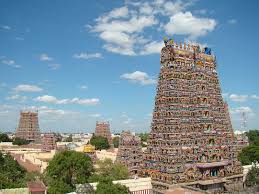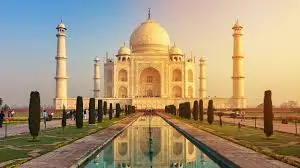The Meenakshi Temple in Madurai, Tamil Nadu, is a magnificent Dravidian-style Hindu temple dedicated to Goddess Meenakshi and Lord Sundareswarar, renowned for its towering gopurams, intricate sculptures, and spiritual significance.
ADVERTIDEMENT

Table of Contents

Meenakshi Temple (Madurai, Tamil Nadu)
The Meenakshi Temple, located in the historic city of Madurai, Tamil Nadu, is one of the most celebrated temples in India, renowned for its architectural grandeur and spiritual significance. Dedicated to Goddess Meenakshi (a form of Goddess Parvati) and her consort Lord Sundareswarar (a form of Lord Shiva), this temple is a masterpiece of Dravidian architecture, attracting millions of devotees and tourists annually.
Believed to have been originally built in ancient times, the temple was significantly expanded during the reign of the Nayak dynasty in the 16th century. It is known for its towering gopurams (gateway towers), intricately adorned with thousands of colorful sculptures depicting gods, goddesses, and mythical beings. These gopurams, some reaching over 50 meters in height, are visible from afar, symbolizing the temple’s spiritual prominence.
The sprawling temple complex spans 14 acres and includes multiple sanctums, halls, and corridors. The Hall of Thousand Pillars, a marvel of symmetry and stonework, features intricately carved columns that depict legendary tales and figures. The temple also houses a sacred tank, the Golden Lotus Pond, where devotees perform rituals and gather for prayers.
The Meenakshi Thirukalyanam, or celestial wedding of Meenakshi and Sundareswarar, is an annual festival that draws thousands of devotees and showcases the temple’s cultural vibrancy. Beyond its spiritual importance, the temple serves as a cultural hub, celebrating art, music, and dance traditions.
The Meenakshi Temple stands as a timeless symbol of Tamil Nadu’s architectural brilliance and religious heritage, embodying centuries of devotion and craftsmanship. It is not only a place of worship but also a testament to the artistic and spiritual legacy of South India.
I. Introduction
The Meenakshi Temple, situated in the ancient city of Madurai, Tamil Nadu, is one of the most iconic and revered Hindu temples in India. Dedicated to Goddess Meenakshi, an incarnation of Goddess Parvati, and her consort Lord Sundareswarar, a form of Lord Shiva, the temple is a center of spiritual devotion and architectural brilliance. It serves as a pilgrimage site for millions of devotees every year and is renowned worldwide for its intricate Dravidian-style architecture.
The temple is more than a religious monument; it is a cultural hub that reflects the artistic and spiritual richness of Tamil Nadu. Its towering gopurams (gateway towers) and detailed sculptures make it a beacon of South Indian heritage, attracting tourists, historians, and art enthusiasts alike.
II. Historical Background
Origins
The origins of the Meenakshi Temple are steeped in mythology and history. According to legend, the city of Madurai was built by Indra, the king of gods, after he discovered a self-manifested Shiva Lingam in the area. Goddess Meenakshi, believed to be an incarnation of Parvati, is said to have ruled Madurai and later married Lord Sundareswarar in a celestial wedding celebrated to this day.
Historically, the temple’s roots trace back to Sangam literature, which references the temple and its significance in ancient Tamil culture. However, much of the temple was rebuilt during the Nayak Dynasty in the 16th century, particularly under the patronage of Tirumalai Nayak, who expanded the temple into the sprawling complex it is today.
Nayak Contributions
During the Nayak era, the temple underwent significant architectural enhancements. The grand gopurams, intricate carvings, and elaborate halls were constructed, transforming it into a magnificent structure that became a central part of Madurai’s identity. The Nayak rulers also institutionalized festivals and rituals that are still observed in the temple today.
III. Architectural Features
Gopurams (Gateway Towers)
The temple is famous for its 12 towering gopurams, each adorned with thousands of colorful sculptures depicting gods, goddesses, demons, and mythical beings. The tallest gopuram, the South Tower, stands at over 50 meters, serving as a visual landmark for miles around. Each tower is intricately painted and features detailed carvings that narrate Hindu mythology and epic tales.
Hall of Thousand Pillars
One of the architectural highlights is the Hall of Thousand Pillars, a testament to the craftsmanship of the Nayak period. Each of the 985 intricately carved stone columns is unique, depicting divine figures, mythical creatures, and scenes from Hindu epics. The hall also serves as a museum, showcasing artifacts, statues, and historical relics.
Golden Lotus Pond
The temple complex houses the Golden Lotus Pond, a sacred tank where devotees perform purification rituals. Surrounded by pillared corridors, the pond is a serene space believed to cleanse sins and enhance spiritual purity. According to legend, the pond was used to judge the worthiness of literary works during ancient Tamil Sangam assemblies.
Sanctums
The temple has two primary sanctums: one dedicated to Goddess Meenakshi and the other to Lord Sundareswarar. Both sanctums are intricately adorned with murals, carvings, and gold-plated features. The inner sanctums are accessible to devotees for worship, creating a deeply spiritual experience.
IV. Cultural and Spiritual Significance
Religious Importance
The Meenakshi Temple is a major pilgrimage site for Hindus, symbolizing the divine union of Shiva and Parvati. It is particularly significant for devotees of Goddess Meenakshi, who is revered as a warrior goddess and ruler of Madurai. Worship at the temple is believed to bring blessings, prosperity, and spiritual fulfillment.
Festivals
The temple comes alive during festivals, especially the Meenakshi Thirukalyanam, a 10-day celebration of the celestial wedding of Meenakshi and Sundareswarar during the Chithirai Festival. Thousands of devotees gather to witness the grand processions, cultural performances, and elaborate rituals. Other festivals, like Navaratri and Shivaratri, also highlight the temple’s vibrant cultural traditions.
Cultural Hub
Beyond its religious role, the Meenakshi Temple serves as a hub for Tamil culture, art, and music. The temple hosts performances of classical Bharatanatyam dance, traditional Carnatic music, and other art forms, keeping Tamil Nadu’s rich heritage alive.
V. Tourism and Legacy
Attraction for Tourists
The Meenakshi Temple is one of India’s most visited temples, drawing millions of tourists and devotees each year. Its architectural grandeur, spiritual ambiance, and vibrant festivals make it a must-visit destination for travelers seeking cultural and religious experiences.
Economic and Cultural Impact
The Meenakshi Temple plays a pivotal role in the local economy, supporting tourism and cultural preservation efforts. It also acts as a source of pride for the people of Madurai, embodying the city’s historical and cultural identity.
Art and Architecture
As a UNESCO World Heritage tentative site, the Meenakshi Temple is celebrated globally for its architectural brilliance. The intricate carvings, vibrant colors, and meticulous craftsmanship showcase the skill of ancient Tamil artisans and their devotion to creating timeless masterpieces.
VI. Challenges and Preservation
Preservation Challenges
Over centuries, the temple has faced challenges such as weathering, pollution, and the impact of high footfall from devotees and tourists. The colorful sculptures and paintings require frequent restoration to maintain their vibrancy.
Conservation Efforts
The Hindu Religious and Charitable Endowments Department oversees the maintenance and restoration of the temple. Efforts include preserving the intricate carvings, repainting the gopurams, and implementing measures to manage the environmental impact of tourism.
VII. Conclusion
The Meenakshi Temple stands as a timeless symbol of Tamil Nadu’s spiritual and cultural heritage. Its intricate architecture, deep-rooted mythology, and enduring traditions make it a beacon of devotion and artistry. Visiting the temple is not just a religious experience but also an opportunity to explore the rich history and culture of South India.
As a testament to centuries of craftsmanship and faith, the Meenakshi Temple continues to inspire awe and reverence, ensuring its place as one of India’s greatest architectural and spiritual treasures.

